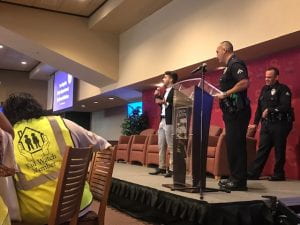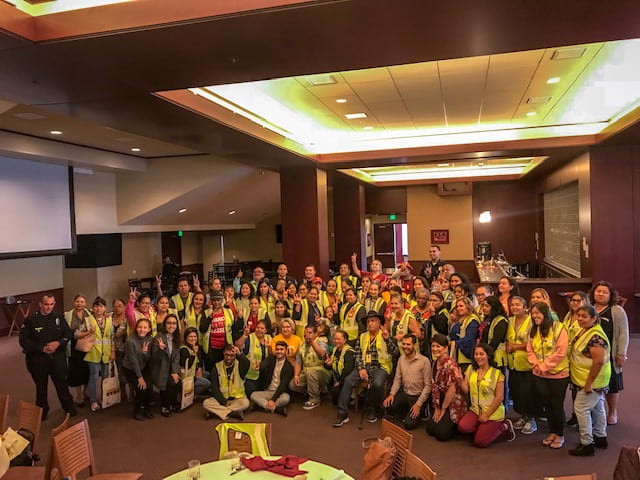When the USC Kid Watch program was launched more than two decades ago, the area surrounding the six Family of Schools was a far cry from today’s bustling corridor (prior to the Galen Center, the USC Village, the Expo line, Banc of California Field) and the children walking to and from school on their own were susceptible to street crimes and other safety issues.
The goal of the program was to keep children safe by empowering the residents of the neighborhood to become a formidable neighborhood watch. Neighbors would look out for children as they walk to and from school, in the morning and afternoon. The safe passageways created by Kid Watch ambassadors, as the volunteers are referred to within the program, prevent bullying, and gang influence as well as deter street crimes.
Over the years the program has evolved as street crimes in the area surrounding Norwood Elementary, Weemes Elementary, Vermont Elementary, Mack Elementary, 32nd Street Magnet and Foshay Learning Center has subsided. Street and traffic safety has become a focal point of the program. The Kid Watch safety valet program was introduced to create a safe environment in designated drop off locations.
“A big issue in our schools is vehicle and pedestrian safety, cars that double park or parents that park their car in the middle of the street and take their kids out of the car and walk them across a busy street,” says Irvin Jerez, program manager for Kid Watch. “It not only causes a lot of traffic, but it also creates a very dangerous situation.”

The safety valet program has been a popular addition, not only with the schools and parents, but with the kids under the watchful eye of the program. “Our Kids Watch ambassadors are the first people that the kids see when they arrive at school,” says Jerez. “It builds familiarity between our ambassadors and our kids. It builds trust, and kids feel comfortable. They know that our Kid Watch ambassadors are someone they can look for when they need help.”
While the goal of the program is to ensure the safety of children, it also empowers the community members who volunteer their time. They are empowered through training and information sessions that teaches them skills such proper reporting protocols and self-defense. At a recent public safety conference, the ambassadors were introduced to various safety partners in the program, including USC’s Department of Public Safety, the Los Angeles Police Department (LAPD) and the Los Angeles County Metropolitan Authority (Metro).
“The conference is designed to support our Kid Watch ambassadors and the Kid Watch membership to hear about what they signed up for, as well as to hear from our safety partners,” says Kim Thomas-Barrios, associate senior vice president of K-12 educational partnerships. “They go over what they may see, what they have to deal with and who do they report to. It’s a way to build trust, which you develop more easily when you have personally met a person that represents a law enforcement agency. It bridges the gap when it comes to reporting and it goes a long way into creating relationships between our safety partners and our community members.”
The enduring history of the program is due to its successful collaboration between the community, parents, schools and safety partners with the goal of keeping children safe by getting neighborhood residents involved.
“When you feel like you have a voice, you feel like you are involved. You feel like you have a role in keeping the community safe. Nothing feels hopeless,” says Captain Edgar Palmer, USC Department of Public Safety. “You need community partners in order to keep the community safe.”
